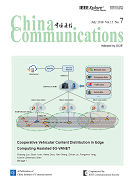Guest Editorial
Guiyang Luo, Quan Yuan, Haibo Zhou, Nan Cheng, Zhihan Liu, Fangchun Yang, XueminShen
2018, 15(7): 1-17.
By leveraging the 5G enabled vehicular ad hoc network (5G-VANET), it is widely recognized that connected vehicles have the potentials to improve road safety, transportation intelligence and provide in-vehicle entertainment experience. However, many enabling applications in 5G-VANET rely on the efficient content sharing among mobile vehicles, which is a very challenging issue due to the extremely large data volume, rapid topology change, and unbalanced traffic. In this paper, we investigate content prefetching and distribution in 5G-VANET. We first introduce an edge computing based hierarchical architecture for efficient distribution of large-volume vehicular data. We then propose a multi-place multi-factor prefetching scheme to meet the rapid topology change and unbalanced traffic. The content requests of vehicles can be served by neighbors, which can improve the sharing efficiency and alleviate the burden of networks. Furthermore, we use a graph theory based approach to solve the content distribution by transforming it into a maximum weighted independent set problem. Finally, the proposed scheme is evaluated with a greedy transmission strategy to demonstrate its efficiency.
